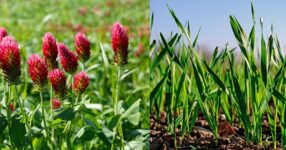Q • I’ve read that planting a cover crop in fall can be good for a vegetable garden, but I don’t know much about it. Can you give me some information about cover crops for home gardens?
A: While typically used in agriculture, home gardeners can benefit from using cover crops in their gardens. Cover crops can help reduce erosion, improve soil quality and fertility, and reduce weeds.
Cover crops are planted, allowed to grow and need to be cut down before they produce seed to prevent future weed problems. In the St. Louis area, cool-season cover crops are planted in fall (September-October) or spring (March-April), while warm-season cover crops are typically planted in June or July.
Several plant species make good fall cover crops and are generally categorized as grasses, forbs, or legumes. Some cool-season grasses include cereal rye, oats, or winter wheat. Tillage radishes and field turnips are common cool-season forbs, while cool-season legumes like crimson or berseem clover and winter peas can fix nitrogen from the atmosphere and add it to the soil.
People are also reading…
While planting a single species is often easier to manage, a two or three-way mixture can increase benefits to soil. Typically, the earlier you establish a cover crop in the fall, the better it will grow. While some cover crops will be killed by the cold, others may persist through the winter, so be sure to watch plants for the start of seed formation. If plants start producing seed, cut them down and let them sit for several days. Then till or turn all cover crop biomass (including roots) into the soil, which should be done at least two to four weeks before planting the garden in spring. For more information about cover crops, visit extension.purdue.edu/extmedia/HO/HO-324-W.pdf.
Write to the Missouri Botanical Garden’s Center for Home Gardening at plantinformation@mobot.org or the Horticulture Answer Service, 4344 Shaw Blvd., St. Louis, MO 63110.




